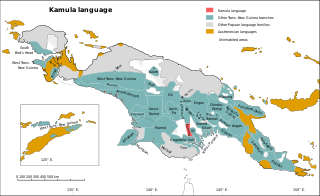
The Papuan languages are the non-Austronesian and non-Australian languages spoken on the western Pacific island of New Guinea, and neighbouring islands, by around 4 million people. It is a strictly geographical grouping, and does not imply a genetic relationship. The concept of Papuan peoples as distinct from Austronesian-speaking Melanesians was first suggested and named by Sidney Herbert Ray in 1892.
Bauni is a language spoken in Barupu (Warapu) village of West Aitape Rural LLG, Sandaun Province, Papua New Guinea.
Purari (Namau) is a Papuan language of Papua New Guinea.
Amanab is a Papuan language spoken by 4,400 people in Amanab District, Sandaun Province, Papua New Guinea.

Abom is a nearly extinct language spoken in the Western Province of Papua New Guinea. According to a 2002 census, only 15 people still speak this language. All of the speakers are older adults. Middle-aged adults have some understanding of it, but no children speak or understand Abom.

The Maimai languages constitute a branch of the Torricelli language family. They are spoken just to the west of Nuku town in eastern Sandaun Province, Papua New Guinea.

The Tama languages are a small family of three clusters of closely related languages of northern Papua New Guinea, spoken just to the south of Nuku town in eastern Sandaun Province. They are classified as subgroup of the Sepik languages. Tama is the word for 'man' in the languages that make up this group.
Awtuw (Autu), also known as Kamnum, is spoken in Sandaun Province, Papua New Guinea. It is a polysynthetic language closely related to Karawa and Pouye. It is spoken in Galkutua, Gutaiya, Kamnom, Tubum, and Wiup villages in Kamnom East ward, East Wapei Rural LLG, Sandaun Province.

Nuku, also known as Nuku Station, is the capital of Nuku District in Sandaun Province, Papua New Guinea. It is located within Mawase Rural LLG.

Kamula is a Trans–New Guinea language that is unclassified within that family in the classification of Malcolm Ross (2005). Noting insufficient evidence, Pawley and Hammarström (2018) leave it as unclassified.

Tabo, also known as Waia (Waya), is a Papuan language of Western Province, Papua New Guinea, just north of the Fly River delta. The language has also been known as Hiwi and Hibaradai.
Beli is a Torricelli language of Papua New Guinea. It is also known as Akuwagel, Makarim, Mukili.
Yessan-Mayo is a Papuan language spoken by 2000 people in Papua New Guinea. It is spoken in Maio and Yessan villages of Yessan ward, Ambunti Rural LLG, East Sepik Province.
Sepik Iwam, or Yawenian, is a language of Papua New Guinea. It is the lexical basis of the Hauna trade pidgin.
Karami is an extinct and unclassified Papuan language of southern Papua New Guinea. It is attested from only a short word list, which include many loans from Foia Foia.
Chenapian (Chenap) is a Papuan language of East Sepik Province, Papua New Guinea. It is spoken in Chepanian (Sanapian) village, Ambunti Rural LLG.
Bitur is Papuan language of Western Province, Papua New Guinea.
Dibiyasoa.k.a.Bainapi is a Papuan language of Western Province, Papua New Guinea.
Turumsa is a possibly extinct Papuan language of Makapa village in Gogodala Rural LLG, Middle Fly District, Papua New Guinea. It has been classified as a Bosavi language, and is 19% lexically similar with Dibiyaso, but this appears to be due to loans. It has a greater (61%) lexical similarity with Doso, its only clear relative.
Laeko, or Laeko-Libuat, is a Torricelli language of Papua New Guinea.







